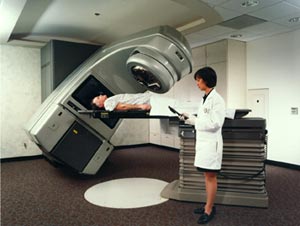- Table 1- Tolerance dose to an organ based on giving the dose in one fraction or fractionated,
using TD5/5 (5% chance of injury showing up over the next 5 years) and TD 50/5 (50% chance
of an injury)
- Table 2
- Tolerance dose if entire organ is treated with a single dose and the expected
complication
- Table 3
- Tolerance dose if fractionated and whole or partial organ is hit
- Table 4- Tolerance dose based on the percent of the organ hit by the radiation
and here
- Dose constraints for normal tissues are now well
defined in IMRT protocols (go
here)
|
Parameters of Therapy: Tolerance Doses (TD5/5TD50/5)
|
Single
Dose (Gy)x |
Fractionated Dose (Gy) |
|
Ovary |
26 |
Testes |
12 |
|
Bone marrow |
210 |
Ovary |
610 |
|
Testes |
210 |
Eye (lens) |
612 |
|
Eye (lens) |
210 |
Kidney |
2030 |
|
Mucosa |
520 |
Thyroid |
2040 |
|
Gastrointestinal |
510 |
Lung |
2328 |
|
Lung |
710 |
Skin |
3040 |
|
Colorectal |
1020 |
Liver |
3540 |
|
Kidney |
1020 |
Bone marrow |
4050 |
|
Vasculoconnective tissue |
1020 |
Heart |
4350 |
|
Liver |
1520 |
Gastrointestinal |
5055 |
|
Skin |
1520 |
Vasculoconnective tissue |
5060 |
|
Peripheral nerve |
1520 |
Spinal cord |
5060 |
|
Spinal cord |
1520 |
Brain |
5570 |
|
Brain |
1525 |
Peripheral nerve |
6577 |
|
Heart |
1820 |
Mucosa |
6577 |
|
Bone and cartilage |
>30 |
Bone and cartilage |
>70 |
|
Muscle |
>70 |
Muscle |
>70 |
|
From Rubin P. Law and order of
radiation sensitivity: absolute versus relative. In:
Vaeth JM, Meyer JL, eds. Frontiers of radiation therapy
and oncology. Basel: Karger; 1989:740, with permission. |
|
|
Normal Tissue Tolerance to Therapeutic
Irradiation
|
Organ |
TD5/5
Volume |
TD50/5
Volume |
Selected End
Point |
|
1/3 |
2/3 |
3/3 |
1/3 |
2/3 |
3/3 |
|
Kidney |
50 |
30 |
23 |
|
40 |
28 |
Clinical nephritis |
|
Brain |
60 |
50 |
45 |
75 |
65 |
60 |
Necrosis, infarction |
|
Brainstem |
60 |
53 |
50 |
|
|
65 |
Necrosis, infarction |
|
Spinal cord |
5 cm: 50 |
10 cm: 50 |
20 cm: 47 |
5 cm: 70 |
10 cm: 70 |
20 cm: |
Myelitis, necrosis |
|
Lung |
45 |
30 |
17.5 |
65 |
40 |
24.5 |
Pneumonitis |
|
Heart |
60 |
45 |
40 |
70 |
55 |
50 |
Pericarditis |
|
Esophagus |
60 |
58 |
55 |
72 |
70 |
68 |
Clinical
stricture/perforation |
|
Stomach |
60 |
55 |
50 |
70 |
67 |
65 |
Ulceration, perforation |
|
Small intestine |
50 |
|
40 |
60 |
|
55 |
Obstruction,
perforation/fistula |
|
Colon |
55 |
|
45 |
65 |
|
55 |
Obstruction,
perforation/ulceration/fistula |
|
Rectum |
Volume: 100 cm3 |
60 |
Volume: 100 cm3 |
80 |
Severe proctitis/necrosis/fistula |
|
Liver |
50 |
35 |
30 |
55 |
45 |
40 |
Liver failure |
TD, tolerance dose.
From Emami B, Lyman J, Brown A, et al.
Tolerance of normal tissue to therapeutic
irradiation. Int J Radiat Oncol Biol Phys
1991;21:109122, with permission. |
|
|
|
